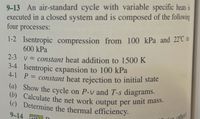Question

Transcribed Image Text:(a) Show the cycle on P-v and T-s diagrams.
(b) Calculate the net work output per unit mass.
9-13 An air-standard cycle with variable specific heats is
executed in a closed system and is composed of the following
four processes:
1-2 Isentropic compression from 100 kPa and 22°C 1o
600 kPa
2-3 v = constant heat addition to 1500 K
3-4 Isentropic expansion to 100 kPa
4-1 P= constant heat rejection to initial state
%3D
(b) Calculate the net work output per
(c) Determine the thermal efficiency.
unit mass.
9-14 S D
nther)
(or
Expert Solution
This question has been solved!
Explore an expertly crafted, step-by-step solution for a thorough understanding of key concepts.
This is a popular solution
Trending nowThis is a popular solution!
Step by stepSolved in 6 steps with 5 images

Knowledge Booster
Similar questions
- 50 GOA lab sample of gas is taken p through cycle abca shown in the p-V diagram of Fig. 18-43. The net work done is +1.2 J. Along path ab, the change in the internal energy is +3.0 J and the magnitude of the work done is 5.0 J. Along path ca, the energy trans- ferred to the gas as heat is +2.5 J. How much energy is transferred as heat along (a) path ab and (b) path bc? a b -V Figure 18-43 Problem 50.arrow_forward9.-What is the change in internal energy of the isochoric process (from point A to point B)?arrow_forwardConsider 2 moles of an ideal monatomic gas at 350 K and 1 atm. First, let the gas expand isothermally and reversibly to twice the initial volume; Second, let this be followed by an isentropic expansion from twice to four times the initial volume. a) How ch heat (in added to the gas in each of these two processes? b) What is the temperature at the end of the 2nd process? c) suppose the 1st process is replaced by an irreversible expansion, into a vacuum, to a total volume twice the initial volume. What is the increase of entropy in the irreversible expansion (in J/K)?arrow_forward
- An air-standard cycle is executed within a closed piston– cylinder system and consists of three processes as follows: 1-2 V = constant heat addition from 100 kPa and 27C to 700 kPa 2-3 Isothermal expansion until V3 = 7V2 3-1 P = constant heat rejection to the initial state Assume air has constant properties with cv = 0.718 kJ/kg·K, cp = 1.005 kJ/kg·K, R = 0.287 kJ/kg·K, and k = 1.4. (a) Sketch the P-v and T-s diagrams for the cycle. (b) Determine the ratio of the compression work to the expansion work (the back work ratio). (c) Determine the cycle thermal efficiency.arrow_forwardCorrection: "There is an adiabatic expansion to point B"arrow_forward2.0 moles of an ideal gas is initially at P = 1.0 atm and T = 300 K. It is then taken through a three-step reversible process: (i) isobaric expansion to twice its original volume; (ii) isothermal compression, returning to its original volume; (iii) isochoric reduction in pressure to the original state. Find the work done on the gas in each step of the process and the net work done on the gas for the process.arrow_forward
- Based on the thermodynamic properties provided for water, determine the amount of energy needed for 2.20 kg of water to go from -14.0 °C to 74.0 °C.arrow_forwardCombustion products in a gas turbine expand adiabatically from a pressure of 4 bar and a temperature of 880ºC to a pressure of 1 bar and a temperature of 550ºC. Assuming the reversible path 1-b-2 and that the process 1-b is adiabatic, determine the ∆s. Consider the value of Cp = 1 J / g Karrow_forwardtwo canisters A and B each contain 0.20 mol of a diatomic gas at 400k and a pressure of 405300 Pa. A expands isothermally and B adiabatically until pressure of each is 303975 Pa. [for a diatomic gas Cv = (2/5) R 1) Sketch both processes on a single PV diagram 2) What are the final temperature and final volume of each canisterarrow_forward
arrow_back_ios
arrow_forward_ios